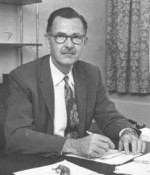Dr. Burns
Meet the man behind the microscope, Dr. George W. Burns...
 A tall and stately man, Dr. George W. Burns has been described as affable to students, professors, and administrators. He liked to connect with people, and was often found bantering with students or anyone who shared a passion for discussion. Dr. Burns welcomed students in his office to talk about planning of classes, life, difficulties, or just conversation. Funding for the SEM Lab was given from past students of Dr. Burns, as well as a gift from Gordon V. ’54 and Helen Crider ’56 Smith.
A tall and stately man, Dr. George W. Burns has been described as affable to students, professors, and administrators. He liked to connect with people, and was often found bantering with students or anyone who shared a passion for discussion. Dr. Burns welcomed students in his office to talk about planning of classes, life, difficulties, or just conversation. Funding for the SEM Lab was given from past students of Dr. Burns, as well as a gift from Gordon V. ’54 and Helen Crider ’56 Smith.
Dr. Burns made everything interesting; students loved him for his ability to enthrall them and pursue greater interests in class topics. He published two successful textbooks in plant science: The Science of Genetics: An Introduction to Heredity, 4th and 5th Editions. Both texts were published for the international market and are on display in the SEM lab.
Dr. Burns's interests were mainly botany, genetics, and meteorology. During World War II, he was one of the first to fly missions into hurricanes in order to study typhoons.
During his years at OWU, he maintained his passion for meteorology and was the official weatherman for the department. Students would ask Dr. Burns what the weather was going to be like over spring break in the areas they were traveling to.
He also enjoyed studying paleoweather events and glacial geology. Dr. Burns was involved with The Ohio State University's institute of polar science, where he served as a botanist for two American Geographical Society field parties that studied glaciers in southern Alaska. He and his fellow society researchers studied the relation of climate changes to glacier behavior during this time.
More about Dr. Burns
Dr. Burns became an assistant professor at OWU in 1946, and reached full professor in 1954, serving until his retirement in 1979. While at OWU, he served as chairman of the Botany-Bacteriology Department from 1954 to 1970; acting vice president and dean, 1957-59; acting president, 1958-59; and vice president and dean, 1959-60. He won the President Herbert Welch Meritorious Teaching Award in 1966.
Dr. Burns was a fellow of the American Association for the Advancement of Science and served as secretary and executive vice president of the plant science section. He was secretary, vice president, and president of the Ohio Academy of Science, and was a member of the American Genetic Association, the American Society of Human Genetics, the American Institute of Biological Sciences, the Arctic Institute of North America, the Botanical Society of America, and Sigma Xi.
He received a bachelor’s degree in botany from the University of Cincinnati in 1937 and a doctorate in botany from the University of Minnesota in 1941.
Everybody Has Their Little Quirks!
 Dr. Burns was very fussy about accuracy. He planned the whole day by exact time frames, which could not be off by even a minute, not even to start early. His wife, Hermine Burns, remembers calling him one day and saying she would pick him up from work at 4:30 or 4:35. He then asked which time she would come, either exactly at 4:30 or exactly at 4:35. Also, when Dr. Burns would travel at night from the University of Minnesota to Cincinnati, he would sit behind the University of Minnesota student union until the clock struck midnight before he would start his trip.
Dr. Burns was very fussy about accuracy. He planned the whole day by exact time frames, which could not be off by even a minute, not even to start early. His wife, Hermine Burns, remembers calling him one day and saying she would pick him up from work at 4:30 or 4:35. He then asked which time she would come, either exactly at 4:30 or exactly at 4:35. Also, when Dr. Burns would travel at night from the University of Minnesota to Cincinnati, he would sit behind the University of Minnesota student union until the clock struck midnight before he would start his trip.
A Brief Timeline of Events
- A graduate of the University of Minnesota, Dr. Burns joined the OWU faculty in 1946 and was named Chair of the Botany/Bacteriology Department in 1954.
- He served as Professor, Dean, Vice President, and Acting President during his distinguished career at Ohio Wesleyan.
- He retired from Ohio Wesleyan in 1979.
- The SEM Laboratory was named after Dr. George Burns by Gordon and Helen Crider Smith (’54/’56).
- The Burns-Shirling Award was established by alumni and friends upon Dr. Burns's retirement. It is given annually to the student who demonstrates outstanding achievement in Botany/Microbiology.
